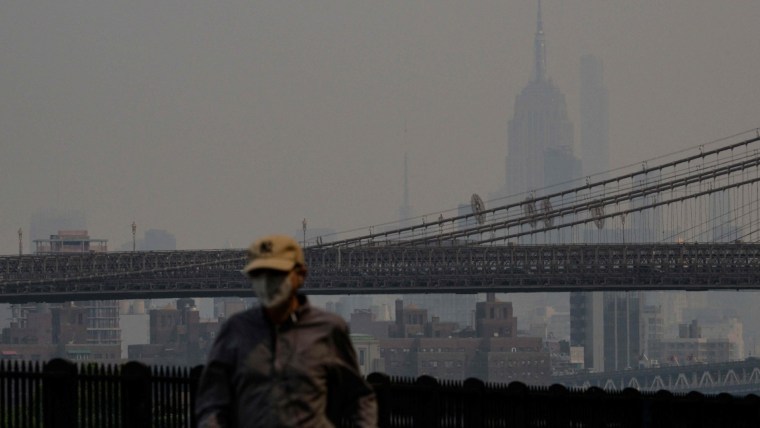The air quality in places like New York City, Philadelphia and other areas of the Northeast on Wednesday may give pause to outdoor exercise enthusiasts, including runners.
The air quality index, or AQI, in New York exceeded 200 late Tuesday — briefly ranking as the worst in the world — as smoke from wildfires in eastern Canada wafted into the United States.
Follow live coverage on U.S. air quality conditions and Canada’s wildfires.
The AQI runs from 0 to 500; higher numbers indicate greater levels of air pollution and greater health concerns, according to the Environmental Protection Agency.
Once levels exceed 150, running outdoors may become risky, said Dr. Panagis Galiatsatos, a pulmonologist with the American Lung Association.
“It’s like swimming in polluted water,” he said.
“You’re going to get irritated, probably 20 minutes into your jog,” he said. “You’ll develop a cough, some dryness and you may even get a little bit more breathless because what you’re trying to do is some level of endurance, but your lungs aren’t breathing in healthy air, they’re breathing in toxins, they’re breathing in noxious stimuli. You’ll feel that toll.”
Dr. Hugh Cassiere, a pulmonary specialist and director of critical care services at South Shore University Hospital in New York, said that the intensity of the exercise and proximity to the wildfire matters, too.
“If I’m on a leisurely walk, I may not be inhaling a large volume at any one time, but if I’m running or jogging, I’m inhaling a large amount of respiratory gases,” Cassiere said.
“If I’m 5 miles from the wildfire, versus 5,000 miles from the wildfire, I’m going to have a different density of the smoke that I inhale. That can have a big effect on my breathing, whether I’m exercising or not,” he said.
Being farther away from the wildfire doesn’t necessarily mean you’re in the clear, however.
Wildfire smoke contains airborne particles. The larger ones, which tend to cause irritation in the eyes, nose and throat, don’t drift far from the source.
But fine particulate matter — the tiny particles that measure less than 2.5 micrometers in diameter — can travel long distances in the air. It’s these tiny particles that can make their way into the lungs, and from there, the blood, Galiatsatos said.
These particles may not cause the air to change color or smell, so your eyes and nose “may not be a reasonable indicator” of air quality, he said.
If a person does decide to run outside anyway, they should wear a tight-fitting mask, Galiatsatos said. Exercising indoors with an air purifier, like a HEPA filter, may be a better solution, he added.
Follow NBC HEALTH on Twitter & Facebook.







